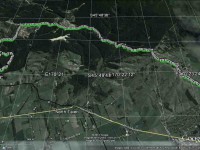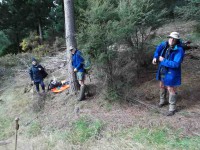21/5/2014.Trampers: Nth Taieri Church, logging site, Mill Stream Rd, Silver Stream Rd. Car Shuttle. M

4 intrepid trampers turned up to do a walk that had never been done before by the club. The weather was not looking good, but we set off to leave one car at the Silverstream end, then came back to the Nth. Taieri Church, and walked up the muddy paddock to the restored cottage, where we had an early morning tea break. After this we walked up the track along the valley, which we found to be quite difficult due to fallen bushes across the track. Once into the pine forest the going was a lot clearer, but much steeper, & we worked up a bit of sweat climbing through here, so it was off with some clothing. When the top was reached at the farm paddocks, the wind was very brisk [& cold] so wind break clothing was quickly donned again. The walk along the farm road was uneventful, but when we reached the logging road we had to watch out for the trucks using it.
We walked past the log processing site, & into City forests, [which I forgot to get permission for], and then onto a little used road which lead us to the top of Mill Stream Rd. There was a lot of deer sign down here, but we didn’t see any deer. After crossing Mill Stream, it was a climb up the other side of the valley, where we stopped in the shelter of the trees for lunch, …

… then up again through the back of Strauss’s property to the end of Mill Stream Rd. & onto the track leading down into Silverstream valley, back to the car which we had parked in the farmer’s yard earlier in the day.
The weather was good all day except for a short shower as we came down the track into Silverstream valley, although the wind was quite cold all day.
Everybody agreed it was a good walk, and that they would do it again. – Ken
